temporal and spatial dynamics
CONCEPTUAL GUIDE TO THE TEMPORAL AND SPATIAL DYNAMICS MODULE
Prepared by Deatra Walsh, Leah F. Vosko, Martha MacDonald, Katherine Laxer, Sylvia Fuller and Sandra Ignagni
INTRODUCTION
The temporal and spatial dynamics module deepens our understanding of precarious employment by examining the movement of people through time and space over the life course. It also investigates spatial relationships at sub- and supra-national levels that shape precarious employment and its distribution. Through this module, we strive to move beyond a static understanding of precarious employment by examining variation over time and geographical space and how workers, in different social locations and embedded in various institutional contexts, negotiate these dynamics.
Three central research questions organize the module:
1. How does participation in precarious employment vary over workers’ lifetimes and how is it affected by institutional contexts?
2. How is precarious employment spatially distributed within and across different countries? What accounts for variation?
3. What role does geographic labour mobility or immobility play in perpetuating or fueling precarious employment?
A fourth question is conceptually important for this module. It concerns temporal as opposed to geographic mobility: To what extent are people “locked into” precarious employment? Do the same individuals move from one precarious job to another, or between precarious employment and unemployment or inactivity, or is precarious employment a temporary experience for a larger number of workers? Are women more likely to be “stuck” in precarious employment than men? What accounts for the variation across countries? A longitudinal analysis of labour market flows is needed to address the question of the permanence of precarious employment. But, while this type of analysis is possible through some of the individual datasets used to build the CPD, and while questions of whether people are locked into precarious employment can be analyzed through many of the library resources (e.g., Fuller 2009), it is not possible to pursue longitudinal analysis using the statistical database as a whole due to technical challenges associated with harmonization. The module therefore focuses on the first three questions raised.
This module devotes particular emphasis to: the life course; institutional contexts, including the gender contract and regulatory frameworks that govern employment relations and help shape social policies; spatial dynamics; and, geographic labour (im)mobility.
Quality data are essential to analyzing the dynamics of precarious employment. This conceptual guide thus reviews the availability and limitations of comparative international data addressing the central research questions (see the harmonized codebook + data dictionary). Within these limitations, key indicators are developed that enable users to make useful empirical comparisons across countries. The guide summarizes the choice of indicators within the three main topic areas outlined above, draws attention to significant gaps in statistical data limiting the ability to examine the full range of issues of interest through such means, and points to further resources in the library which may assist users in understanding and filling these gaps through a variety of methods.
KEY CONCEPTS
The Life Course
This module uses the life course as a lens through which to understand the intersection of various phases of life and participation in precarious employment, shaped by institutional contexts.
The life course is a “multilevel” phenomenon, encompassing the flow of individuals through pathways marked by interactions with various social institutions (Elder 1994). It “refers to the interweave of age-graded trajectories, such as employment careers and family pathways, that are subject to changing conditions and future options, and to short-term transitions ranging from leaving school to retirement” (Elder 1994; 1985). That is, individual lives unfold such that social and cultural norms frame, and are framed by, the timing and sequencing of life events and the interdependent relationships held by individuals throughout their lives. It is important to keep in mind that gender is central to this “unfolding”, although other dimensions of social location also combine with gender to shape the life course of an individual.
Through this module, we seek to allow users to study how individuals’ participation in precarious employment across their lives is linked to family structures and household forms and how, in turn, participation in precarious employment during one or more phases of life shapes the sequence and timing of life events and the possibilities for economic security later in life, particularly during retirement. In doing so, our understanding of the life course aims to challenge the association of the “life course” with an employment-centric developmental trajectory, where “atomized and rational” individuals move linearly from phase to phase, and assume full risk for their individual choices (Knijn and Smit 2009).
The module focuses on three life phases – young adulthood, mid-working years, and older adulthood/retirement – where precarious employment may impact individual and household economic security. We recognize that these are not static phases but they do reflect periods where forms of employment and institutional contexts intersect in particular ways.
Young adulthood: young adulthood is often associated with higher risks of precarious employment. Younger workers typically experience greater job insecurity than their older counterparts insofar as they are disproportionately concentrated in part-time or temporary employment. (e.g., Fuller and Vosko 2008; Baranowska and Gebel 2010). Even in permanent employment, young adults encounter greater job insecurity as the “last hired, first fired”. The occupations in which youth tend to be concentrated are also those characterized by relatively high risks for workplace injuries, and low wages (Breslin and Smith 2005; LaRochelle-Côté and Dionne 2009).
Mid Working Years: during mid working years, parenthood (especially having young children and/or many children) has been shown to reduce women’s employment rates, hours of paid work, and earnings while having little effect on men’s (Gornick 2004; Gash 2009). The relationship between motherhood and precarious employment depends, in part, on the household division of labour that contributes to familial provisioning. Unpaid work is important to understanding temporal and spatial dynamics of precarious employment as it structures the labour supply – that is, where, when, and for how long one engages in paid employment is shaped by one’s unpaid work responsibilities. Responsibilities for unpaid domestic work, in particular, and paid work vary by household configurations, with key dimensions including the presence and absence of children, parents, and partners, as well as the labour market profiles of household members. Each of these dimensions can strongly shape individuals’ economic insecurity, and can be unstable over time (Aisenbrey 2009).
Older Adulthood/Retirement: older adults are also at risk for engaging in precarious employment. Employer prejudice against older workers may make re-employment after job loss in later years difficult (Chan and Stevens 2001). Exit patterns to retirement also vary considerably cross-nationally depending on the presence or absence and generosity of public pension systems (Buchholz and Hofäcker 2004; Blossfeld et al. 2006; Ebbinghaud 2006; Azra and Kohli 2008). The timing of retirement depends, to a large extent, on the work history of an individual through earlier life phases. A work history involving large spans of time spent in precarious employment or out of the labour market poses challenges for older workers, especially those who have not paid into a pension plan or had sufficient earnings over the life course to set aside funds needed to exit the labour force (Ginn and Arber 1998; Townson 2000). Gender differences in precarious employment in earlier life stages are mirrored in these differences in later life.
Institutional Contexts
Institutional contexts make a difference in the constraints individuals face and the options they have to choose from with respect to employment over the life course. Patterns of labour force participation and working time arrangements across different life phases vary considerably across countries (Anxo, Fagan, Cebrian and Moreno 2007). Understanding how precarious employment intersects with particular life phases is thus facilitated by a life course perspective that relates individual biographies to the specific institutionalized structures within which they are constructed (Moen 2003). Institutional context includes the gender contract and regulatory frameworks governing employment relations and social policies, including family, taxation, and income security policies.
Gender contract: typically, women’s greater responsibility for unpaid informal caregiving and unpaid domestic work contributes to gender inequalities not just in immediate employment experiences, but also with respect to longer term career prospects, lifetime earnings, and entitlements to pensions and other social benefits provided through welfare state systems (Anxo et al. 2007). Rewards and penalties are embedded in welfare state policies and labour market dynamics that shape the degree to which household structure contributes to employment patterns and risks of employment insecurity. German women, for example, face a higher poverty risk after labour union dissolution than their Swedish and American counterparts, in large part because the strong male-breadwinner bias of German social policy makes non-maternal care for young children difficult to access and inhibits their employment (DiPrete 2002). While single mothers face economic disadvantage across the globe, their participation in paid employment and their risks of poverty in and out of employment vary considerably (Clement et al. 2009).
Household characteristics also play a role in defining employment experiences at other points over the life course. There is strong inter-country variation in the rate at which young people leave the parental home and establish independent households. For example, the chances of leaving home within three to four years after graduation is much lower in Spain (35%) and Italy (45%), than in the United Kingdom (76%) or Norway (95%) (Wolbers 2007a). These differences reflect, in part, the economic conditions of different countries, with higher youth unemployment hindering young people’s ability to strike out on their own. In older adulthood, the male-breadwinner bias underpinning familial pension systems in France, Germany, the Netherlands and Austria, can impose economic penalties on women who do not live in a two-parent household. In countries with individualized pension schemes, such as Sweden and the United Kingdom, women may find it difficult to access pension benefits if the demands of unpaid work have made it difficult to fulfill the financial obligations of these schemes during mid-working years (Frericks, Knijn and Maier 2009).
Regulatory frameworks: as the forms of precarious employment module demonstrates, considering how form of employment is linked to social location and regulatory frameworks governing employment is central to understanding precariousness. This module aims to enable users to expand this understanding across the life course. It thus allows for investigation of the ways in which regulatory frameworks governing employment and welfare state policies intersect with experiences of precarious employment over the life course. Protections and entitlements extended in connection with both employment, via employment regulations, and through the welfare state, via social policies, vary by country. They also differ on sub-national levels. While these differences cannot be easily captured in the statistical data available, this module provides means for addressing their impact on patterns of precarious employment and offers a basis from which to consider their role in shaping the patterns that do emerge from the data partly through library resources and partly through this conceptual guide.
While young adults more frequently find themselves in precarious employment, institutional factors, tied to employment regulations, shape the degree to which this pattern operates. How these factors cluster, and their effects, depend upon the country under consideration. Youth in Canada, for example, are much more likely to earn low wages than their Australian counterparts due to the existence of tiered minimum wage legislation existing in some Canadian provinces (LaRochelle-Côté and Dionne 2009). Factors that tend to decrease precariousness for more established workers actually increase it for newer workers. For example, strong employment protections typically support the interests of more established workers, can create divisions between labour market “insiders” and “outsiders” that can disadvantage those attempting to gain a foothold in the labour force. Indeed, they can result in a greater difference between youth and mid-age unemployment (Blossfeld 2005; Kahn 2007). However, the presence of strong employment protections suggests that when youth do secure employment, it is of higher quality.
Social policies can support or undermine gender divisions of labour, creating different models of earning and caring that shape employment configurations at the individual and household level during mid-working years (e.g., Sainsbury 1994; O’Reilly and Fagan 1998; Lewis 2002; Anxo et al. 2007; Misra, Budig and Moller 2007). In Nordic countries, for example, a “universal breadwinner” model reduces the negative impacts of childbearing on women’s likelihood of being employed than it does in other countries, with mothers typically temporarily reducing their paid working time when their children are young (Anxo et al. 2007). In Italy and Spain, on the other hand, mothers tend to either be employed full-time (especially those with higher levels of education) or, more commonly, to withdraw from the labour force entirely, whereas maternal part-time paid employment predominates in Germany and the United Kingdom (Vosko 2010). Factors that account for these cross-national differences in the patterns of women’s employment include the availability and cost of public childcare, family leave provisions, the size of the public sector, and service sector growth (McGinnity and McManus 2007; Gash 2009).
Pension regimes involving one or more of the following schemes impact exit patterns to retirement in industrialized countries: 1) publicly funded old-age income supplements based on the number of years worked (e.g., Ireland and the Netherlands), a minimum level under which compensation cannot drop (Spain and Belgium), or targeted benefits that link level of compensation to the overall financial well-being of retirees (Sweden and Australia) (Whiteford and Whitehouse 2006); 2) insurance or savings programs that aim to do better than basic, poverty-preventing programs by ensuring higher rates of compensation through either public or privately managed defined benefit or defined contribution systems (Whiteford and Whitehouse, 2006); and 3) private personal saving schemes that offer individualized, market-based approach to income management during retirement (Townson 2000). In earning-related schemes that assume life-long permanent employment associated with the standard employment relationship, individuals who work part-time while performing unpaid care work (largely women in most CPD countries) have difficulty meeting minimum thresholds required to access social insurance schemes fully, such as pensions, and thus often cannot build up adequate individual claims over the life course (Handler 2004; Frericks et al. 2007). In France, for example, occupationally-based pensions shrink by half, if five of forty insurance years are missed (Veil 2002; Frericks 2009). Whereas some men cannot meet these standards, women who exit the labour force to care for family members are regularly penalized (Esping-Andersen 2002; Frericks 2009). Individuals whose employment histories include long spells of chronic unemployment, underemployment, or part-time paid employment, may remain in the labour force longer than desired.
Spatial Dynamics
Precarious employment is shaped not only by specific job characteristics, phases of the life course and institutional contexts, but also by where people live, and where their workplaces are located (if indeed they do have fixed places of work). There are longstanding spatial dynamics surrounding labour market (in)security that are relevant to the study of precarious employment in comparative perspective. Three such dimensions are regional, rural/urban and intra-urban employment differences and disparities.
Region: in many countries, regional disparities are an important focus of labour market analysis, with certain regions having a disproportionate share of precarious employment. However, the term precarious employment may not be used, as the focus is usually on aggregate labour market measures such as average income or unemployment rates. By reference to regions, we mean sub-national geographic areas — broad groupings that have meaning in a particular country due to physical geography, institutional arrangements, or history. Regions can be broader or narrower than groupings of sub-national jurisdictions. The definition of the area included in a region depends on the focus of inquiry and/or data availability. The differences among regions may be as significant as those among countries, reflecting regional and local labour market characteristics, and sub-national policy. There are important regional disparities in many countries (Northern versus Southern Italy, for example). Some are resource-related, while others emerged in the process of industrialization as industries tended to concentrate spatially. While the increased availability of diverse information technology has overturned some spatial constraints associated with geography, the evidence suggests that the distribution of economic activity remains highly concentrated and spatial inequalities persist. A recent OECD review found that although regional disparities decreased slightly from 1993 to 2003 overall, they “remain relatively persistent” (OECD 2005: 74). There is considerable variation by country, however, both in the extent and trend of regional disparities. Regional differences are relatively strong in Italy, Germany, Belgium, the United Kingdom, and Canada, compared with Australia, the Netherlands and Norway (OECD 2006: 4).
The experience (or consequence) of a certain form of employment may differ by region. It may be easier to move from temporary to permanent employment in a low unemployment region. On the other hand, temporary employment in a poor region may have higher relative status than in a rich region — in fact, it may be the norm. For example, the “good” jobs lost in traditional resource sectors in Atlantic Canada would be considered precarious according to most measures (seasonal, lacking in social protection, often self-employed) (MacDonald 2009). Geographical concentrations of precarious employment, even if industry-based, raise issues of labour market adjustment, especially labour mobility (see discussion of mobility, below). If precarious employment is understood in terms of risks, the risk of having to relocate needs to be considered. Furthermore, if precarious employment is understood as having “gendered contours”, then we can expect that these risks will vary for men and for women across regions, just as they do across countries (Vosko, MacDonald and Campbell 2009). The narrow employment base in a particular region may be more gendered than national averages indicate, or there may be significant sub-national policy differences that affect the gender contract. For example, the province of Quebec has generous policies related to childcare and parental benefits compared to the rest of Canada (Jenson 2002; Tremblay 2007).
To the extent that regional differences matter, an analysis of scale points to institutional mechanisms affecting labour market dynamics at specific levels. These include organizational strategies of firms as well as government policies and community dynamics. For example, footloose firms, whose location decisions are responsive to labour market conditions, may choose to locate in more marginal regions. On the policy side, some programs may be explicitly or implicitly regionally differentiated (such as employment standards, or income security entitlements). Another institutional factor that may be linked to regional differentiation is the structure of collective bargaining (e.g., whether it is regulated at the national or sub-national level and/or is sector/industry- or geographically-based and/or takes place at the enterprise level). Supra-national groupings of countries and commonalities among their social and labour policies, or lack thereof, are also critical in understanding precarious employment in comparative perspective (e.g., in the EU).
Rural/urban: the rural/urban dimension is also an important axis of differentiation, increasingly so in many countries. The definition of rural is usually based on population density and size (with various cut-offs), though the adjacency of urban centres is sometimes factored in, as this affects the nature of the labour market. For example, Statistics Canada now uses a Metropolitan Influenced Zone (MIZ) classification to describe rural areas with fewer than ten thousand people where a significant percentage of workers commute to adjacent larger areas (see McNiven, Purderer and James 2000).
Rural and urban labour markets may differ in the incidence of precarious employment, its demographic distribution, and the mix of employment forms considered precarious. Precarious employment features prominently in many rural areas. For example, recent Canadian studies show a higher incidence of part-time, temporary, seasonal and low-wage employment in rural compared to urban areas (Pérusse 1997; Rothwell 2002; Alasia and Rothwell 2003; Curto and Rothwell 2003). The mix of forms of employment may differ between rural and urban areas. For example, solo self-employment (farmers, fishers, and tourism operators) is high in rural areas. Permanent part-time paid employment may be less available in rural areas, and/or less attractive, than temporary (seasonal) full-time paid employment.
The consequences of precarious employment may also differ across rural and urban contexts. For example, the probability of escaping low-wage employment has been shown to be lower (and its incidence and duration higher) in rural than in urban areas in the United Kingdom, especially for women (Phimister et al. 2006). Canadian researchers have also found a lower probability of moving to a higher wage job among rural low-wage workers (Vera-Toscana et al. 2003). Entitlements to income security protection, such as unemployment insurance, may systematically differ across rural and urban contexts (e.g., Vosko 2011). Other employment protections may differ by industry or occupation in ways that overlap with an urban/rural divide (e.g., employment standards for agricultural workers, union eligibility of self-employed fishers or farmers). Occupational health risks are also often high in traditional rural resource industries (arthritis and rheumatism, for example, were found to be higher in rural areas in Canada, adjusting for age – Mitura and Bollman 2003). The risk of having to move to look for employment is of particular concern in rural areas, with women generally less mobile than men (MacDonald 2004; Lippel 2006; Phimister et al. 2006).
Intra-urban: another meaningful spatial division that emerges from the literature on the geography of employment is intra-urban (Peck and Theodore 2001; Martin and Morrison 2003). Intra-urban differences refer to those within a city, such as between inner city and suburbs, or by neighbourhood/ward. Work in this area goes back to the early days of labour market segmentation analysis. The comparative mapping of precarious versus secure employment in a metropolitan area is related to residential patterns. Residential segregation, or the concentration of particular groups (e.g., by ethnicity, race, and income level) in particular neighbourhoods, may be related to cross-national differences in precarious employment. Like the other spatial dimensions, the intra-urban example directs attention to the movement of workers and the locational congruence or incongruence of the precarious jobs and the workers who hold them.
Geographic Mobility
A spatial analysis draws attention to the movement of people and jobs across geographies. Though labour mobility refers to all aspects of the movement of workers across jobs and labour markets (including changes in industry or occupation), spatial, or geographic, mobility is often part of this movement. The maintenance of precarious employment in poorer regions is often associated with labour immobility and inadequate labour market adjustment (OECD 2005: 87). On the other hand, precarious employment is also common among mobile groups such as recent immigrants.
There may be pockets of “captive” workers within a country who are available to fill precarious jobs due to their relative immobility (Sassen 2005). For example, women may be less mobile than men, tied to communities where their husbands hold jobs as the primary earner; rural workers may have investments in houses and communities that make the cost of moving prohibitive; inner-city workers may lack the means to commute to better jobs elsewhere in the city.
Precarious employment is also fueled by new sources of vulnerable labour as a result of geographic mobility both within and across borders. This mobility is linked to policies related to international migration, or relocation across national borders (on Canada, see the migration module of the gender & work database), and internal migration, or relocation within a country. Both internal and international migration can take many forms along a continuum from temporary to permanent. OECD data (2006: 151) show considerable variation in internal migration flows, with workers more mobile in the United States and Australia than in Europe. The different dynamics of geographic labour mobility are shaped by many factors, including migration policy, the housing market, social policies, unemployment insurance, and transportation.
Permanent migration: permanent migration workers establish homes in a new country or a new location in a country, typically undertaken in the hope of a better future (less precariousness). However, it can also be associated with a supply of labour with low reservation wages, lack of local experience, and few alternatives but to accept precarious employment. In some countries/regions, precarious employment is fuelled by, and is prevalent among, new immigrants. Research comparing recent immigrants with similar Canadian-born workers documents lower incomes and greater underemployment for the newcomers (Galareau and Morrisette 2004; Palameta 2004).
Similarly, permanent migration of people within a country can also fuel precarious employment. Rural-urban migrants in many countries provide a source of cheap labour. Industrialization, from eighteenth century England to twenty-first century China, has been fueled by such rural-urban mobility and/or the permanent out-migration from poorer economic regions.
Temporary migration: precarious employment may be perpetuated by the use of temporary migrant workers either from within or outside the country. Internal and international temporary migration includes moves intended to be of a defined length, normally with the worker maintaining a home and/or family in the location of origin. Some temporary migrant workers migrate seasonally, for example for jobs in primary industries such as agriculture, construction, and fishing and related secondary processing. Others work “away” for short term contracts that are not seasonal. Although some temporary non-local jobs are not precarious on all dimensions (e.g., they are lucrative and include regulatory protections), they are normally associated with high levels of uncertainty as the jobs lack ongoing, long-term contracts.
The situation for internal temporary migrants and international temporary migrants may differ, especially in terms of access to labour and social rights as well as security of presence. Many countries provide extremely limited rights to temporary migrant workers who are in the country on specific work permits. While these migrants are considered “temporary”, in that they lack the rights of permanent residents and citizens, the time frame during which they remain in this status can be lengthy – i.e., temporary does not necessarily mean short-term, but rather reflects a lack of rights associated with “permanent” migration.
Making the connections: temporary and permanent migration are usually examined separately in the literature (Bell and Ward 1998; 2000). While the distinction between the two is useful for data collection purposes (identification of primary residence, for example), the new mobilities literature emphasizes the continuous and complex mobility patterns that characterize life stories (Urry 2000; Cresswell 2006), returning us to the earlier writings of Zelinksky (1971) on the importance of recognizing circular migration patterns. Both internal and international migration can take many forms along a continuum from temporary to permanent. For example, a move that begins as permanent can be followed by return migration; temporary moves can become permanent, and so on. Thus, spatial and temporal mobility are interwoven. Furthermore, while temporary migration is associated with maintaining a base in the community of origin, permanent migrants also maintain connections with their families and home communities. Remittances, or money earned in the new location that is sent back to members of one’s family who remain in the community of origin, be it in the same or a different country, constitute important economic and social linkages between the sending and receiving areas. Workers holding precarious jobs in their new communities may thus contribute to reducing insecurities in their households and communities of origin. The literature on remittances concentrates on transnational transactions, but they are also relevant to internal migration.
Public policy can facilitate or discourage geographic mobility, both its permanent and temporary variants, and can affect the extent to which such mobility (or immobility) is associated with precarious employment. Mobility for persons holding citizenship in the EU 27 has been enhanced in the EU by legislation permitting EU nationals to work in other EU countries (Dobson and Sennikova 2007; Ederveen et al. 2007). In Canada, provincial and territorial governments are introducing new legislation associated with the Canadian Agreement on Internal Trade to eliminate interprovincial labour mobility barriers (Grady and Macmillan 2007; Government of Canada 2009).
Many countries have programs that bring in internal and international temporary migrants for hard-to-fill jobs and/or programs that encourage recent immigrants to accept precarious employment. In Canada, for example, temporary migrant workers may be recruited from abroad to fill so-called temporary labour/skill shortages, normally on finite bases.[1] Such recruitment is often for jobs that workers in Canada do not want, such as seasonal agricultural and live-in domestic work.
Workers who access jobs by physically moving, either permanently or temporarily, are differentiated along gender, class and racial lines. Women, for example, are generally found to be more restricted in their mobility options (due to childcare, transportation, gendered immigration policy, tied migration and other constraints) and to be less likely to improve their earnings as a result of migration (Morrison and Lichter 1988; Finnie 1999; Gabriel 2004). Thus, they risk being either stuck in precarious employment due to lack of mobility or relegated to precarious employment in a new area when they migrate. Despite this, a feminization of migration has occurred since the 1980s with increasingly more women moving internally and across national borders (Castles and Miller 1993; Donato et al. 2006; Willis and Yeoh 2000). Racial and ethnic differences in mobility constraints and consequences are also significant and may explain some of the distributional patterns found in the precarious employment literature (Cranford and Vosko 2006).
Institutional contexts, reflected in employment and social policies, as well as in gender contracts, are particularly important in shaping mobility options and consequences. Housing, transportation, training, child care and unemployment insurance policies all shape the interaction of precarious employment and geographic labour mobility across countries, regions, rural/urban areas, and city neighbourhoods. Comparative research has much to teach us about these dynamics.
INDICATORS
The temporal and spatial dynamics module is guided by four key concepts: the life course, institutional contexts, spatial dynamics, and geographic mobility. Applying these key concepts to the data requires drawing upon a variety of variables available through the CPD’s harmonized database. The module is most strongly associated with variables found under the four of the eight indicator sets outlined in the harmonized codebook + data dictionary: demographics and social location, household context, geography and time, and migration and mobility. The module also uses variables grouped under indicators of work context and regulatory protection, and under indicators of income and benefits.
Life Course
Stages, or phase, of the life course are best measured through a combination of variables associated with social location and demographics, and household context. Because the temporal and spatial dynamics module focuses predominantly on young adulthood, mid-working years, and older adulthood/retirement, age is the most obvious choice for a life course indicator and is available in three formats in the CPD (DE2G1; DE2G2; DE2G3). Age alone, however, may be insufficient as a variable because it cannot always act as a proxy for a particular life phase. It should therefore be used in conjunction with other indicators of family structures or household forms, such as household type (HC2G1) or whether or not there are children in the household (HC3G1). Although more normative in nature, marital status (HC1G1) can also be used in conjunction with age.
Institutional Context
Institutional context encompasses the interacting aspects of the gender contract and regulatory frameworks. Indicators of institutional context must therefore be closely aligned with household characteristics, work context and regulatory protection, and income and benefits. To reflect the gender contract, sex (DE1G1) can be used in conjunction with marital status (HC1G1) and/or household type (HC2G1). Household characteristic variables that reflect the presence (HC3G1), and age of the youngest child (HC4G1) can also be used as indicators of the gender contract.
Indicators of regulatory frameworks include variables that reflect establishment and firm size (WC4G1; WC5G1) as these indicators are directly associated with the degree of employment protection and standards upheld within the workplace. Regulatory frameworks vary by whether employment occurs in the public or private sector (WC3G1) and can be reflected in work schedule (WC8G1) and union status (WC6G1); these variables are appropriate indicators of the type and degree of regulatory frameworks present.
Spatial Dynamics
The module offers two main variables that indicate degrees of spatial dynamics as outlined in the conceptual guide. First, a country variable is available which includes each of the countries represented in the dataset (GE1G1). With the exception of GE2G1, which groups all European Union countries, and affiliated states under the subcategory “Europe”, subnational and regional groupings are not available, although users may choose to examine specific European countries together under GE1G1. Through the CPD, rural and urban living environments can be examined for certain countries (MB1G1). In these cases, rural is measured by combinations of population density (in the EU case) and population size (in Canada).
Geographic Mobility
Geographic mobility is central to the temporal and spatial dynamics module. However, we are limited by the extent to which variables are available to indicate all dimensions of geographic mobility. For example, indicators of temporary mobility such as commuting, seasonal migration, and long-distance commuting are not available through the database.
The main CPD indicator of geographic mobility is migration, and migration specific to permanent relocation. Migration variables were not available in all data sets. Variables in the CPD only measure migration in the EU and Australia. The CPD migration variables are temporally and spatially specific: MB2G1 (EU LFS) measures whether respondents lived in a different country one year ago; MB2G2 (EU LFS), on the other hand, measures whether respondents lived in a different region one year ago. MB3G1 (ECHP) is not temporally specific but measures migration trajectory according to whether the respondent is a stayer (has never left region); a mover (moved from different region or country) or an immigrant.
Australian based migration data are specific to relocation since the previous wave of the survey (MB4G1). In this case, we do not have information about the respondents’ destination of origin before the move, only indication that s/he moved “households”. In the case of our second Australian migration variable (MB4G2), we are provided with temporal information regarding migration (i.e., whether the respondent lived in the household for less than 10 years). This is the only temporal migration information available through the CPD. All other migration variables are spatial in nature. We have adopted the approach of grouping years in order to work around the challenges of very small sample sizes and survey suppression guidelines. We believe, as our third demonstration shows below, that this is a good method for analyzing important populations in the labour force who are typically invisible in statistical terms, such as recent migrants.
We turn now to our three analytical demonstrations of the statistical data of the temporal and spatial dynamics module. Before working through the demonstrations, it is recommended that users read through the CPD statistics tutorial to gather a basic understanding of how to modify and manipulate the Beyond 20/20 multidimensional tables.
STATISTICS DATABASE
The cross-national comparative statistical tables of the CPD, using the indicators described above, enable researchers to focus on aspects of precarious employment in relation to themes of temporal and spatial dynamics. The statistics database can be used to obtain basic information on a topic (e.g., cross-national comparisons of women’s labour force participation) or to examine complex social relations (e.g., gendered precariousness in different countries). The statistical tables are displayed in Beyond 20/20, enabling users to manipulate the data. University and community users doing non commercial research and teaching may access the statistical data. For more information on the data harmonization approach of the CPD, please consult the introduction. Below we have provided links to the statistics database and to information on how to apply for access. Following these links we provide three demonstrations of the data available within the temporal and spatial dynamics module using our key questions as guides to showcase CPD indicators.
statistics database
DEMONSTRATION 1
The Influence of Children in the Household on Employment Form for Men and Women: Comparing Germany, France and the United Kingdom
This demonstration examines the relationship between household responsibilities (via the presence or absence of children in the household) and precarious employment. It is designed to address the first question of the temporal and spatial dynamics conceptual guide, namely: How does participation in precarious employment vary over workers’ lifetimes and how is it affected by institutional contexts? We consider this through a comparison of the differing employment form distributions among men and women with children in Germany, France and the United Kingdom. As noted, employment forms are associated with varying degrees of precariousness, depending on the institutional context. Hence this demonstration uses form of employment as a means to gauge aspects of precariousness experienced by workers.
As research shows, women usually take on greater caregiving and unpaid domestic responsibilities than men, especially as they enter into their prime working age years, a time which often coincides with having children. The temporal and spatial dynamics module is concerned with institutional contexts as they relate to the life course and to precarious forms of employment. In the CPD, institutional contexts are measured best through a cross-national comparison, as they point to different state welfare systems that either support or hinder women’s participation in the labour force. For example, in Germany, a male-breadwinner model of household organization, and a strong maternalist ideology, remains pervasive (Hofäcker, Stoilova and Riebling 2013; Fasang, Aisenbrey and Schoemann 2009). This demonstration will examine the distribution of employment forms as it relates to household responsibility, using gendered, temporal and cross-national lenses. Here, household responsibility is indicated through the presence or absence of children in the household.
Table 1: Form of Employment by Presence of Children under 18 in the Household by Sex, Germany, 2011
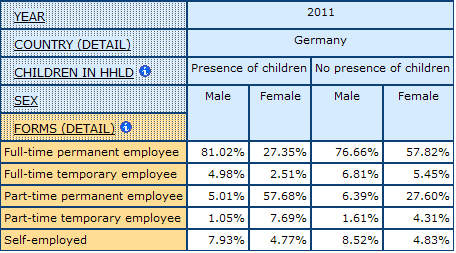 Source: CPD table TSD HC-1
Source: CPD table TSD HC-1
As can be seen above in Table 1, the presence of children in the household shapes the gendered participation rate in different employment forms. Fewer women with children in Germany are employed full-time and permanently. Perhaps more significantly, when we compare the rate of full-time, permanent employment for women with and without children, we are able to see the impact that children have on women’s labour market participation. For women with no children in the household, their full-time paid employment status is much higher than for women with children, but the difference is considerably less among men with and without children in the household. In other words, a high percentage of men have permanent full-time jobs (over 70%) regardless of whether there are children in the household, whereas women’s employment status in such jobs (i.e., full-time permanent) is strongly impacted by children.
If we look now to the forms of employment more frequently linked to precariousness, those working part-time either on a permanent or temporary basis, we see higher proportions of women in this category than men, irrespective of the presence of children in the household. Meanwhile, the proportion of female part-time temporary employees with children is 8.4%, much higher than for men with or without children. To better visualize these gender differences we have constructed a graph comparing these proportions (Chart 1).
Chart 1: Visualization of Form of Employment by Presence of Children under 18 in the Household by Sex, Germany, 2011
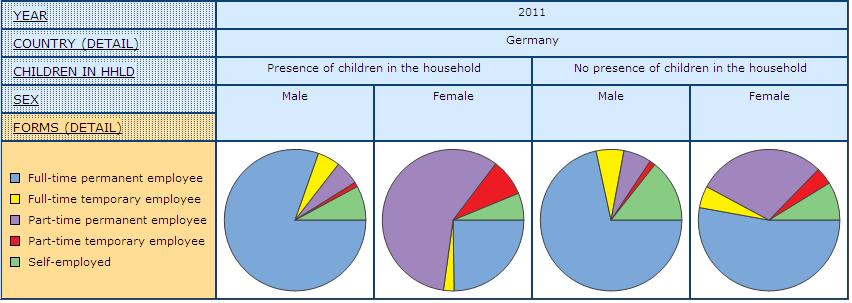 Source: CPD table TSD HC-1
Source: CPD table TSD HC-1
We can clearly see in Chart 1 that the highest proportion of women workers with children fall into the category of part-time permanent employees. These findings are consistent with the literature showing that women’s household responsibilities (e.g., children) do impact the type and extent of their labour market participation, but the same is not true for men (Gornick 2004; Gash 2009). Are these gendered employment trends indeed specific to Germany? It is generally understood that while gendered patterns of labour market participation are somewhat universal (i.e., they can be seen across countries), there are important differences between nations because of divergent institutional contexts, regulatory frameworks, and cultural differences (Anxo et al. 2007; O’Reilly 1996; Rubery and Fagan 1995). Germany is one of the largest western European countries. We have chosen to compare Germany to two of the other largest countries in Europe: France and the United Kingdom.
Table 2: Form of Employment by Presence of Children under 18 in the Household by Sex, Germany, France and the United Kingdom, 2011
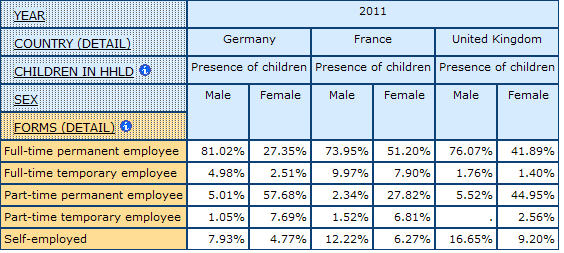 Source: CPD table TSD HC-1
Source: CPD table TSD HC-1
As can be seen in Table 2, there are clear differences between the three countries in the distributions across employment forms for men and women with children in the household. For example, in 2011 there are much larger proportions of women with children working permanently and full-time in the United Kingdom and France as compared to in Germany. Some of the factors that scholars have identified as influencing these rates include welfare protections, demographic issues and family-care models (Lane 1993; Windebank 2001). In all three countries, proportions of permanent part-time workers are highest for those with children in the household. Yet, there are significant differences between the countries, raising the question of why rates of part-time work for women with children differ between the three countries.
Chart 2: Visualization of Form of Employment by Presence of Children under 18 in the Household, Women, Germany, France, United Kingdom, 2011
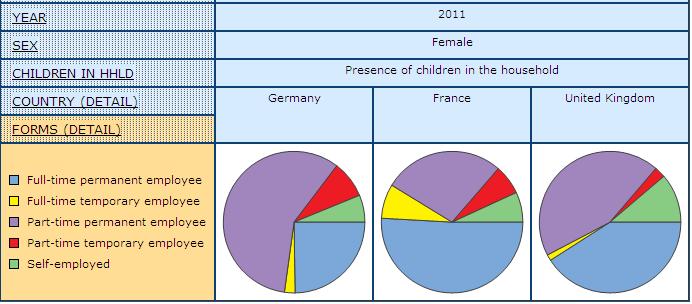 Source: CPD table TSD HC-1
Source: CPD table TSD HC-1
In Chart 2 we provide a Beyond 20/20 visualization of the distribution across employment forms for women with children in the household in Germany, France and the United Kingdom. We see that Germany has the highest rate of part-time permanent employment among women with children in 2011. This pattern may reflect public policy provisions which give employees the right to request reduced working hours (Fagan et al. 2011). Germany has stronger legislation to protect this right whereas the “legislation in the United Kingdom provides for very little redress if the employer rejects the request” (Fagan et al. 2011: 24). Hence, this concentration of women in part-time permanent employment in Germany may be less of an indicator of precarious employment, and instead a reflection of a progressive public policy approach that enables women to maintain their occupational positions in the workforce while preserving work-life balance. Nevertheless, whether part-time work is based on choice or constraint is a topic of considerable debate (Fagan and Walthery 2011).
For women with children, France has the highest share of full-time permanent employment and the lowest share of part-time permanent employment. In short, women with children seem to be most securely employed in France relative to Germany and the United Kingdom. This is likely due in part to national legislation which established the full-time 35-hour work week (Askenazy 2013). In this context, and not withstanding some institutional changes over the past decade, women are perhaps better able to balance full-time paid employment with other demands. Furthermore, France has extensive and universally accessible programs for daycare and early childhood education (e.g., maternelles).
This demonstration has examined the relationship between household responsibilities (via the presence of children in the household) and distributions across employment forms cross-nationally. In the countries examined, the presence of children in the household does not affect participation in the labour force among men in the same way that it does for women. The results show that higher proportions of men with and without children are permanent full-time employees. Meanwhile, higher proportions of women can be found in permanent and temporary part-time positions in all three countries. It is also clear that institutional contexts are different for Germany, when compared to France and the United Kingdom, given continuities in maternalist welfare policies and programs embedded in national institutional and regulatory contexts. Cross-national comparative research of this kind supports the view that labour market participation and concentrations in forms of employment that are frequently associated with precariousness are highly gendered.
DEMONSTRATION 2
The Public and Private Sectors in Rural and Urban Contexts: Comparing Canada and Australia
This demonstration addresses the second question of the temporal and spatial dynamics conceptual guide: how is precarious employment spatially distributed within and across different countries and what accounts for variation? To address this question, we examine differences in forms of employment in the public and private sectors as they relate to rural and urban living environments through a comparison of Canada and Australia.
To begin, the distribution of public and private sector employment varies across rural and urban environments. Urban labour markets are generally diverse. Rural areas, especially those that act as regional service centres, tend to have concentrations of public sector employment with large shares of women. This employment is often considered desirable because, in contrast to other common employment found in rural areas (e.g., solo self-employment and part-time, seasonal work), public sector work is associated with good benefit coverage and greater regulatory protections. These public sector jobs are usually considered “good” rural jobs (MacDonald, Sinclair and Walsh 2012). On the other hand, while rural private sector employment can offer the same protections, particularly for full-time employees, it may be more or less precarious depending upon the geographic area and the size of the enterprise. This demonstration will first examine the gendered distribution of public and private sector employment across rural and urban environments.
Table 3 shows shares of employees in the public and private sectors in urban, intermediate-urban and rural areas in Canada and Australia in 2010. Interestingly, the shares are notably similar in the two countries and in each area, with the exception of rural areas, where there are larger concentrations of workers in public sector employment in Australia than in Canada. Generally, approximately 20-25% of the workforce in Canada and Australia is in the public sector and this is true in urban and intermediate-urban areas.
Table 3: Public and Private Sector by Rural and Urban, Canada and Australia, 2010
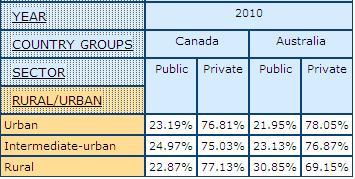 Source: CPD table TSD FE-1
Source: CPD table TSD FE-1
However, when considering gender, the concentrations shift, as is demonstrated in Table 4. In 2010, women in both Canada and Australia have higher shares in public sector employment and this is true in urban, intermediate-urban, and rural areas. Once again the shares are similar in the two countries with the exception being for rural, where Australia has higher shares of both women and men in public sector employment.
Table 4: Public and Private Sector by Rural and Urban and by Sex, Canada and Australia, 2010
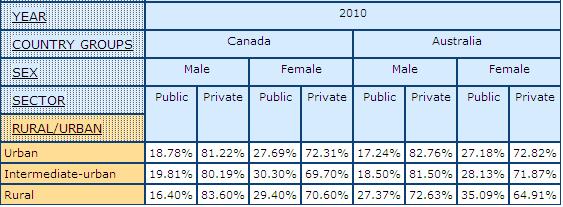 Source: CPD table TSD FE-1
Source: CPD table TSD FE-1
Here again we use employment form – this time the distribution of workers in full- and part-time paid employment – to examine precariousness. Generally, women have higher concentrations in part-time paid employment, employment that is frequently associated with lower union coverage, fewer social benefits such as health, dental and pension insurance, and less regulatory protection. However, as is demonstrated in Table 5, fewer women in public sector employment work part-time than their counterparts in the private sector. This is true in both Canada and Australia, although part-time paid employment is much higher overall for women in Australia as compared to Canada. The different concentrations of men in full- and part-time paid employment are not considerable when comparing the public and private sectors, confirming that the public sector protects women from some forms of employment associated with precariousness.
Table 5: Public and Private Sector by Full- and Part-time Paid Employment and by Sex, Canada and Australia, 2010
 Source: CPD table TSD FE-1
Source: CPD table TSD FE-1
Chart 3 provides a Beyond 20/20 visualization of the concentrations of women in full- and part-time paid employment in the public and private sectors for Canada and Australia in 2010. This visualization clearly shows the difference between the two countries, with Australia having more women in part-time paid employment as compared to Canada. It also demonstrates that in both countries, fewer women work in part-time paid employment in the public sector than in the private sector. These simple visualizations available within Beyond 20/20 can help users of CPD data to quickly identify differences in distributions across countries or indicators.
Chart 3: Visualization of Public and Private Sector by Full- and Part-time Paid Employment for Women, Canada and Australia, 2010
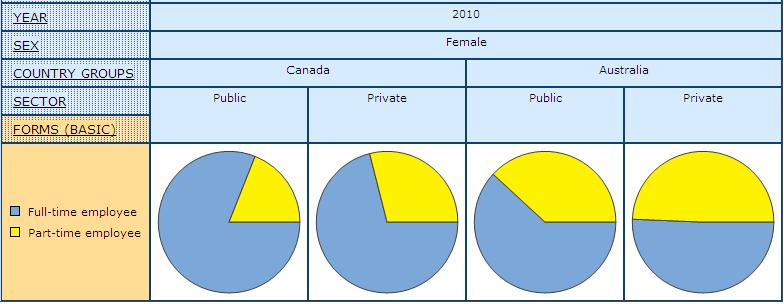 Source: CPD table TSD FE-1
Source: CPD table TSD FE-1
We now turn to a consideration of how shares in part- and full-time paid employment in the public and private sectors differ according to urban or intermediate-urban setting. Our aim here is to consider whether or not the public sector offers the same protection against part-time paid employment for women in non-urban environments. Chart 4 provides a visualization of the concentrations of women in full- and part-time paid employment in the public and private sectors in urban and intermediate-urban settings. Shares are quite similar in these two geographic contexts in Canada. However, as Chart 5 demonstrates for Australia, shares are very different in urban and intermediate-urban settings. Women working in the public sector in intermediate-urban environments in Australia are nearly equally likely to work part-time as women working in the public sector in urban settings. However, women working in the private sector in intermediate-urban settings are much more likely to work part-time than their counterparts in urban settings. This difference between Canada and Australia suggests that sector and urban/intermediate-urban setting interrelate in different ways in these two countries and that women in both the private sector and non-urban settings in Australia are especially precarious when considered in terms of concentrations in part-time paid employment.
Chart 4: Public and Private Sector by Full- and Part-time Paid Employment for Women in Urban and Intermediate-urban Settings, Canada, 2010
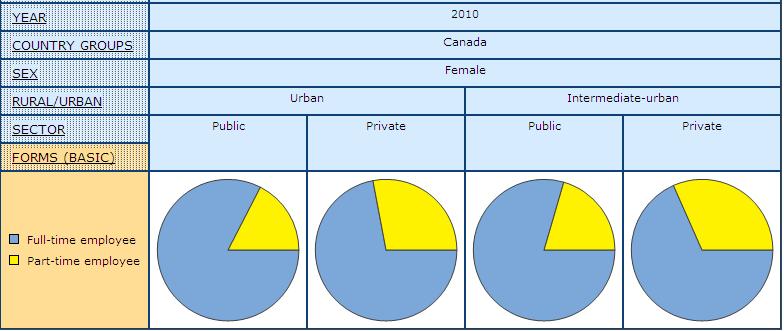 Source: CPD table TSD FE-1
Source: CPD table TSD FE-1
Chart 5: Public and Private Sector by Full- and Part-time Paid Employment for Women in Urban and Intermediate-urban Settings, Australia, 2010
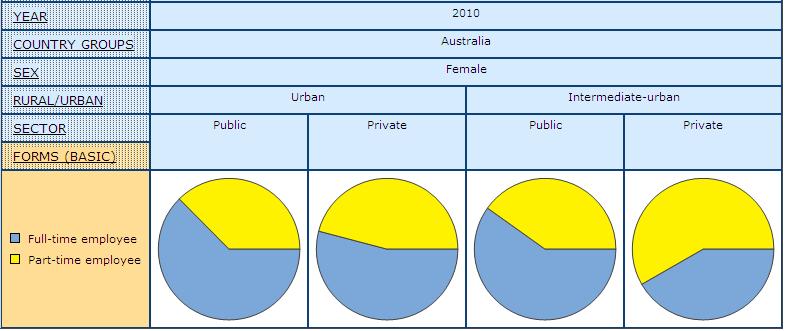 Source: CPD table TSD FE-1
Source: CPD table TSD FE-1
To summarize this second demonstration, the proportion of women in full-time paid employment is higher across urban and intermediate-urban settings in Canada and in Australia. These proportions shift when considering private sector employment. Shares of men in full-time paid employment are higher in the private sector than for women. Not surprisingly, shares of women working part-time in both the public and private sector, across all geographies, are well above those of their male counterparts. In general, more women are concentrated in public sector employment. Furthermore, this is true for women in urban, intermediate-urban and rural settings. When considering part- and full-time paid employment across the two sectors and across geographic setting, we find that the public sector offers a buffer against part-time paid employment in all settings and this especially true in Australia. Public sector employment, for women, offers the promise of less precarious employment, particularly in rural areas (MacDonald et al. 2012; Walsh forthcoming). Moreover, the public sector in both Canada and Australia represents one of the few areas of employment in which the standard employment relationship remains dominant. Positions in this sector tend to be highly unionized and have higher benefit coverage (which can be seen in other tables of the temporal and spatial dynamics module not demonstrated here).
DEMONSTRATION 3
Social Location and Precarious Employment Patterns of Recent Immigrants: Comparing Germany, France and the United Kingdom
This demonstration addresses the third question of the temporal and spatial dynamics module: what role does geographic labour mobility or immobility play in perpetuating or fueling precarious employment? In this case, we examine people who have migrated in the last year from another country, once again comparing Germany, France and the United Kingdom.
While we recognize that migration is only one form of geographic mobility (i.e., other forms of mobility can include mobile work as well as commuting), and that migration does not always occur because of employment, it is the best indicator of mobility available through our harmonized data. We focus on individuals who have moved from another country within the last year and so are recent immigrants. Our intention in this demonstration is to examine the relationship between mobility, gender, age, employment form, and precariousness. Unfortunately, we cannot investigate whether individuals moved for employment or whether they moved and then sought employment. Nor do we know if individuals have moved permanently. However, we can say some things about who moves and what sort of work they end up in with the data available within the CPD. In order to yield sample sizes large enough to avoid suppression on recent migrants, we take the approach in the CPD of grouping years of data into five year groupings. For this demonstration, we use data from the 2007-2011 grouping.
To begin, Tables 6 & 7 and Chart 6 demonstrate that in each of the three countries, most people who have migrated from another country in the previous year are men. Indeed, as Table 7 shows, in Germany 56.8% of people who have migrated from another country in the previous year are men, in France this share is 59.5% and in the United Kingdom it is 60.5%. Chart 6 provides a Beyond 20/20 visualization of these shares.
Table 6: Counts of Men and Women Who Have Migrated from another Country in the Previous Year, Germany, France, United Kingdom, 2007-2011
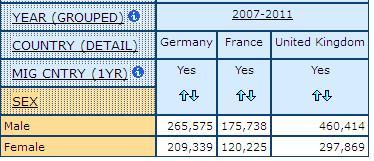 Source: CPD table TSD MB-1A
Source: CPD table TSD MB-1A
Table 7: Calculated Shares of Men and Women Who Have Migrated from another Country in the Previous Year, Men and Women, Germany, France, United Kingdom, 2007-2011
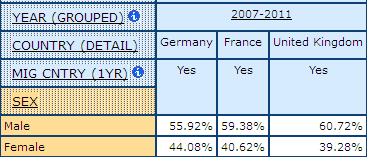 Source: CPD table TSD MB-1A
Source: CPD table TSD MB-1A
Chart 6: Visualization of Shares of Men and Women Who Have Migrated from another Country in the Previous Year, Men and Women, Germany, France, United Kingdom, 2007-2011
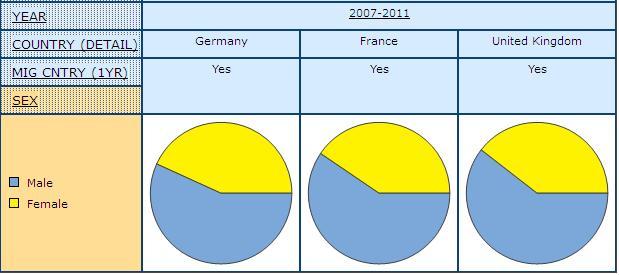 Source: CPD table TSD MB-1A
Source: CPD table TSD MB-1A
Age group distributions are also similar across the three countries. Between 2007 and 2011, among those who migrated from another country in the previous year, most were between the ages of 25-44. Furthermore, slightly larger shares of people migrating from another country were in the age category 15-24 than in the category 45-64, suggesting that recent immigrants tend to be young in all three countries.
Chart 7: Shares of Age Groups Who Have Migrated from another Country in the Previous Year, Germany, France, United Kingdom, 2007-2011
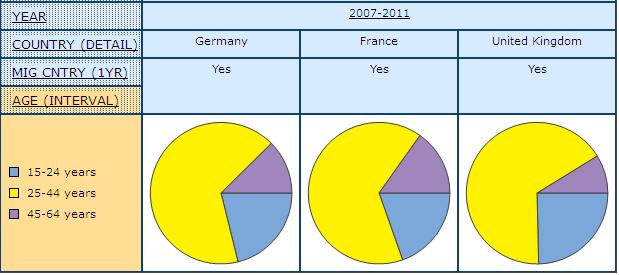 Source: CPD table TSD MB-1A
Source: CPD table TSD MB-1A
For our consideration of precarious employment among people who have recently migrated from another country, we look at form of employment, industry and income. When comparing form of employment among recent immigrants in Germany, France and the United Kingdom, two things stand out (Charts 8 & 9). First, the distribution of recent immigrants across the forms is remarkably different in Germany than in France and the United Kingdom which are similar to one another. In particular, there are far fewer full-time permanent employees among recent immigrants in Germany. Furthermore, there are many more part-time permanent and part-time temporary employees among recent immigrant in Germany than among those in France and the United Kingdom. This suggests that recent immigrants end up in more forms of employment associated with more precariousness in Germany given that temporary employment lacks long term continuity and part-time paid employment is linked with lower benefit and union coverage along with lower wages.
Chart 8: Shares of Workers Who Have Migrated from another Country in the Previous Year by Form of Employment, Germany, France, United Kingdom, 2007-2011
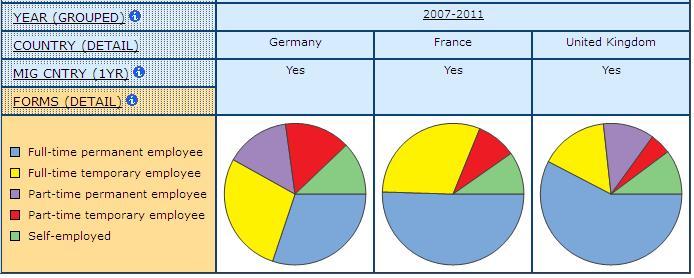 Source: CPD table TSD MB-1A
Source: CPD table TSD MB-1A
Secondly, as Chart 9 demonstrates, the distribution of those who have not migrated from another country in the previous year across the forms of employment is very different from recent immigrants and this is true for all three countries. As we can see in Chart 9, among those who have not migrated in the last year, most work in full-time permanent employment. Meanwhile. fewer non-recent immigrants work in full-time temporary employment than do recent immigrants (Chart 8). Finally, more non-recent immigrants work in part-time permanent employment as compared to recent immigrants. In other words, those who have not recently migrated tend to be more likely to work in permanent employment. Interestingly, Germany does not stand apart from France and the United Kingdom when looking at forms of employment for those who have not migrated in the last year, as the distributions in each of the three countries are similar.
Chart 9: Shares of Workers Who Have Not Migrated from another Country in the Previous Year by Form of Employment, Germany, France, United Kingdom, 2011
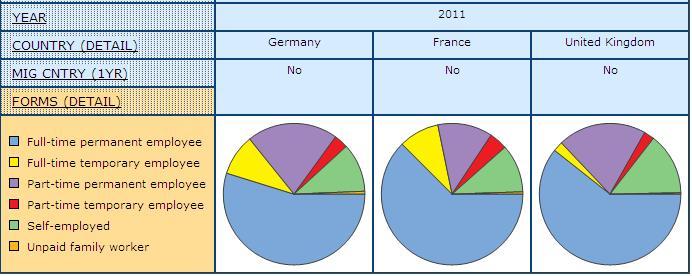 Source: CPD table TSD MB-1A
Source: CPD table TSD MB-1A
Considering industry is one way to understand why people move and how this is related to employment. Looking at people who have migrated from another country in the previous year, we can see that the industries in which recent immigrants end up working are different for the three countries in this demonstration. In particular, as Table 8 shows for the period of 2007-2011, the largest share of recent immigrant workers in Germany is in the services industry. Meanwhile, the largest count in the United Kingdom is in manufacturing and, though this is also the case in France, fewer overall end up in manufacturing in France. In both France and the United Kingdom recent immigrants show high counts in trades and services. Notably, while both Germany and the United Kingdom have many recent immigrants working in accommodation and food services, this is not the case in France where the count was so low for this period it was suppressed. Thus, the role of recent immigrants in the labour market is different for Germany, France and the United Kingdom, reflecting differences in their national economies. Further, some industries are more associated with precarious employment than others which also relates to national context. In this demonstration we can see that Germany depends on recent immigrants for services, while France depends on recent immigrants for manufacturing and trades almost equally, and the United Kingdom depends on recent immigrants for trades. Finally, Table 8 demonstrates how small sample sizes and suppression, even when grouping years as we have done for some data within the CPD, limit the ability to analyze important populations in the labour force, such as recent immigrants.
Table 8: Counts of Recent Immigrants by Industry, Germany, France and the United Kingdom, 2007-2011
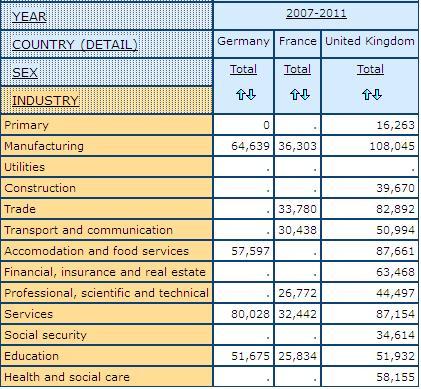 Source: CPD table TSD MB-7A
Source: CPD table TSD MB-7A
Our final indicator of precariousness in this demonstration is personal annual income. However, the data from the CPD on recent immigrants are from the European Labour Force Survey which does not provide any data on income or earnings for the CPD. Data available on income and earnings for the EU countries is from the SILC, which only has data on immigrants and non-immigrants, not on recent migrants. Hence, for this last part of our third demonstration, we consider personal income for immigrants and non-immigrants in Germany, France and the United Kingdom.
Table 9 shows the average annual personal incomes for immigrants and non-immigrants and for men and women in 2011 in the three countries. In general, we find that non-immigrants have higher average annual personal incomes than immigrants across the countries. However, the differences are gendered and how they are gendered differs considerably across these three countries. In Germany, men who are immigrants earn slightly more than men who are non-immigrants. Meanwhile, women immigrants in Germany earn much less than women non-immigrants. Conversely, women immigrants in the United Kingdom earn slightly more than women non-immigrants, while men immigrants earn considerably less than their non-immigrant counterparts in the United Kingdom. In France, both men and women immigrants earn less than men and women non-immigrants.
Table 9: Average Annual Personal Income for Immigrants and Non-Immigrants, Men and Women, Germany, France, United Kingdom, 2011
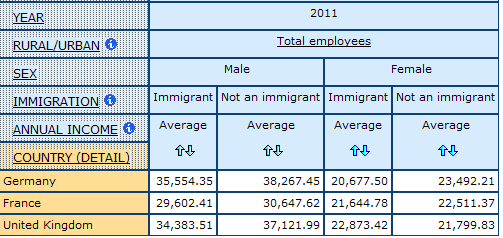 Source: CPD table TSD DE-3
Source: CPD table TSD DE-3
Chart 10 provides of visualization of average annual personal income for women immigrants and non-immigrants in the three countries. Here we see clearly that the gap between immigrants and non-immigrants is largest for German women, while we also see that immigrant women in the United Kingdom earn slightly more on average than non-immigrant women.
Chart 10: Visualization of Average Annual Personal Income, Immigrants and Non-Immigrants, Women Only, Germany, France, United Kingdom, 2011
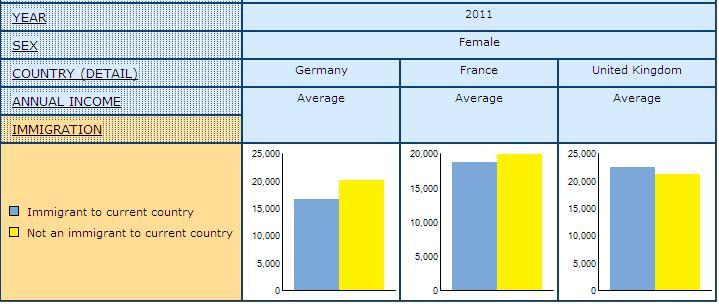 Source: CPD table TSD DE-3
Source: CPD table TSD DE-3
To conclude, each of these demonstrations showcase the statistical data available within the temporal and spatial dynamics module and how these data can be used to illustrate how the gendered nature of precarious employment differs across temporal and spatial contexts. To show the temporal nature of precarious employment, we use the presence of children in the household as a means to reveal how this period of working life is highly gendered and differs by national context. Our spatial analysis includes an examination of rural and urban contexts and of migration. We find more precarious employment in rural contexts but that the public sector mitigates this, particularly for women, and particularly in Australia. Further, we find that recent immigrants are more precarious than non-recent immigrants and that this is especially the case in some national contexts, such as Germany, where recent immigrants end up in more insecure forms of employment such as temporary work, and where women immigrants have lower relative incomes. Our approach of grouping years as a means to work around the challenges of small sample sizes and survey suppression is a unique approach to analyzing recent immigrants, allowing users to see patterns for an important population of the labour force that would otherwise be invisible.
WORKS CITED
Aisenbrey, S. (2009). “Economic Penalties and Rewards of Family Formation, Gender and Education in the Low-income Sector in Germany.” The British Journal of Sociology, 60(1). 95-121. doi:10.1111/j.1468-4446.2008.01220.x
Alasia, A., and Rothwell, N. (2003). “The Rural/Urban Income Divide is Not Changing: Income Disparities Persist.” Rural and Small Town Canada Analysis Bulletin, 4(4).
Anxo, D., Fagan, C., Cebrian, I., and Moreno, G. (2007). “Patterns of Labour Market Integration in Europe: A Life Course Perspective on Time Policies.” Socio-Economic Review, 5(2), 233. doi:10.1093/ser/mwl019
Arza, C., and Kohli, M. (2008). Pension Reform in Europe: Politics, Policies and Outcomes. London and New York: Routledge.
Askenazy, P. (2013). “Working Time Regulation in France From 1996 to 2012.” Cambridge Journal of Economics, 37(2), 323-347. doi: 10.1093/cje/bes084
Baranowska, A., and Gebel, M. (2010). “The Determinants of Youth Temporary Employment in the Enlarged Europe.” European Societies, 12(3), 367-390. doi:10.1080/14616690903165434
Bardasi, E., and Gornick, J. C. (2008). “Working for Less? Women’s Part-time Wage Penalties Across Countries.” Feminist Economics, 14(1), 37-72. doi:10.1080/13545700701716649
Bell, M., and Ward, G. (1998). “Patterns of Temporary Mobility in Australia: Evidence From the 1991 Census.” Australian Geographical Studies, 36(1), 58-81. doi:10.1111/1467-8470.00039
Bell, M., and Ward, G. (2000). “Comparing Temporary Mobility With Permanent Migration.” Tourism Geographies, 2(1), 97-107. doi:10.1080/146166800363466
Blossfeld, H. (2005). Globalization, Uncertainty and Youth in Society. London: Routledge.
Blossfeld, H., Buchholz, S., and Hofäcker, D. (2006). Globalization, Uncertainty and Late Careers in Society. London: Routledge.
Breen, R. (2005). “Explaining Cross-national Variation in Youth Unemployment: Market and Institutional Factors.” European Sociological Review, 21(2), 125-134. doi:10.1093/esr/jci008
Breslin, C., and Smith, P. (2005). “Age-related Differences in Work Injuries: A Multivariate, Population-based Study.” American Journal of Industrial Medicine, 48(1), 50-56. doi:10.1002/ajim.20185
Buchholz, S., and Hofäcker, D. (2004). “Late Careers and Career Exits in Times of Accelerating Social Change: Globalization and Its Impact on Late-midlife Workers.” GLOBALIFE Working Paper no. 62.
Campbell, I. (2008). “Australia: Institutional Changes and Workforce Fragmentation.” In S. Lee, and F. Eyraud (Eds.), Globalization, Flexibilization and Working Conditions in Asia and the Pacific. (pp. 115-152). Geneva: ILO.
Castles, S., and Miller, M. (1993). The Age of Migration: International Population Movements in the Modern World. New York: Guilford Press.
Chan, S., and Stevens, A. H. (2001). “Job Loss and Employment Patterns of Older Workers.” Journal of Labor Economics, 19(2), 484-521.
Clement, W., Mathieu, S., Prus, S., and Uckardesler, E. (2009). “Precarious Lives in the New Economy: Comparative Intersectional Analysis.” In L. F. Vosko, M. MacDonald and I. Campbell (Eds.), Gender and the Contours of Precarious Employment. (pp. 240-255). London and New York: Routledge.
Connelly, P. (1978). Last Hired, First Fired: Women and the Canadian Workforce. Toronto: Women’s Education Press.
Connolly, S., and Gregory, M. (2008). “Moving Down: Women’s Part-time Work and Occupational Change in Britain 1991–2001.” The Economic Journal, 118(526), F52-F76. doi:10.1111/j.1468-0297.2007.02116.x
Couch, K. A. and Fairlie, R. (2010). “Last Hired, First Fired? Black-White Unemployment and the Business Cycle.” Demography, 47(1), 227–247.
Cranford, C., and Vosko, L. F. (2006). “Conceptualizing Precarious Employment: Mapping Wage Work Across Social Location and Occupational Context.” In L. Vosko (Ed.), Precarious Employment: Understanding Labour Market Insecurity in Canada. (pp. 43-66). Montreal and Kingston: McGill-Queen’s University Press.
Cresswell, T. (2006). On the Move: Mobility in the Modern Western World. New York: Routledge.
Curto, J., and Rothwell, N. (2003). “The Gender Balance of Employment in Rural and Small Town Canada.” Rural and Small Town Canada Analysis Bulletin, 4(3).
Davies, R., and Pierre, G. (2005). “The Family Gap in Pay in Europe: A Cross-country Study.” Labour Economics, 12(4), 469-486. doi:10.1016/j.labeco.2005.05.003
DiPrete, T. A. (2002). “Life Course Risks, Mobility Regimes, and Mobility Consequences: A Comparison of Sweden, Germany, and the United States.” American Journal of Sociology, 108(2), 267-309.
Dobson, J. R., and Sennikova, I. (2007). “From Fundamental Freedom to Political and Economic ‘Hot Potato’ in 50 years: Labour Mobility and Migration Within the EU.” Journal of Business Economics and Management, 8(2), 123-136.
Donato, K. M., Gabaccia, D., Holdaway, J., Manalansan IV, M., and Pessar, P. R. (2006). “A Glass Half Full? Gender in Migration Studies.” International Migration Review, 40(1), 3-26.
Ebbinghaus, B. (2006). Reforming Early Retirement in Europe, Japan and the USA. Oxford: Oxford University Press.
Ederveen, S., Nahuis, R., and Parikh, A. (2007). “Labour Mobility and Regional Disparities: The Role of Female Labour Participation”. Population Economics, 20(4), 985-913. doi:10.1007/s00148-006-0095-6
Elder, G. H. (1985). “Perspectives on the Life course.” In G. H. Elder (Ed.), Life Course Dynamics: Trajectories and Transitions, 1968-1980. (pp. 23-49). Cornell University Press: Ithaca, NY.
Elder, G. H. (1994). “Time, Human Agency, and Social Change: Perspectives on the Life Course.” Social Psychology Quarterly, 57(1), 4-15.
Esping-Andersen, G. (2002). “A New Gender Contract.” In Why We Need a New Welfare State. (pp. 68). New York : Oxford University Press.
Fagan, C., and Rubery, J. (1996). “The Salience of the Part-time Divide in the European Union.” European Sociological Review, 12(3), 227-250.
Fagan, C., Lyonette, C., Smith, M., and Saldana-Tejada, A. (2012). The Influence of Working Time Arrangements on Work-life Integration or ‘Balance’: A Review of the International Evidence. International Labour Office, Conditions of Work and Employment Series No. 32.
Fagan, C., and Walthery, P. (2011). “Individual Working-time Adjustments Between Full-time and Part-time Working in European Firms.” Social Politics, 18(2), 269-299. doi: 10.1093/sp/jxr011
Fasang. A.E., Aisenbrey, S., and Schoemann, K. Divorce and Economic Well-being in Retirement in Britain and Germany. Centre for Research on Inequality and the Life Course, Working Paper 2009-07.
Finnie, R. (1999). “Inter-provincial Migration: A Longitudinal Analysis of Movers and Stayers and the Associated Income Dynamics.” Canadian Journal of Regional Science, 22(3), 227-262.
Frericks, P., Knijn, T., and Maier, R. (2009). “Pension Reforms, Working Patterns and Gender Pension Gaps in Europe.” Gender, Work, and Organization, 16(6), 710-730. doi:10.1111/j.1468-0432.2009.00457.x
Frericks, P., Maier, R., and de Graaf, W. (2007). “European Pension Reforms: Individualization, Privatization and Gender Pension Gaps.” Journal of Social Policy, 36(2), 319-340.
Fuller, S. (2009). “Investigating Longitudinal Dimensions of Precarious Employment: Conceptual and Practical Issues.” In L. Vosko, M. MacDonald, and I. Campbell (Eds.), Gender and the Contours of Precarious Employment. (pp. 226-239). London and New York: Routledge.
Fuller, S., and Vosko, L. F. (2008). “Temporary Employment and Social Inequality in Canada: Exploring Intersections of Gender, Race and Immigration Status”. Social Indicators Research, 88(1), 31-50. doi:10.1007/s11205-007-9201-8
Gabriel, C. (2004). “A Question of Skills: Gender, Migration Policy and the Global Economy. In K. van der Pijl, L. Assassi and D. Wigan (Eds.), Global Regulation: Managing Crises After the Imperial Turn. (pp. 162-176). New York: Palgrave Macmillan.
Galarneau, D., and Morissette, R. (2004). “Immigrants: Settling for Less?” Perspectives on Labour and Income, 5(6).
Gangl, M. (2002). “Changing Labour Markets and Early Career Outcomes: Labour Market Entry in Europe Over the Past Decade.” Work Employment and Society, 16(1), 67-90. doi:10.1177/09500170222119254
Gash, V. (2008). “Preference or Constraint? Part-time Workers’ Transitions in Denmark, France and the United Kingdom.” Work, Employment & Society, 22(4), 655-674. doi:10.1177/0950017008096741
Gash, V. (2009). “Sacrificing Their Careers for Their Families? An Analysis of the Penalty to Motherhood in Europe.” Social Indicators Research, 93(3), 569-586. doi:10.1007/s11205-008-9429-y
Ginn, J., and Arber, S. (1998). “How Does Part-time Work Lead to Low Pension Income?” In J. O’Reilly, and C. Fagan (Eds.), Part-time Prospects. (pp. 156-174). London: Routledge.
Golsch, K. (2003). “Employment Flexibility in Spain and Its Impact on Transitions to Adulthood.” Work, Employment & Society, 17(4), 691-718. doi:10.1177/0950017003174005
Gornick, J. C. (2004). “Women’s Economic Outcomes, Gender Inequality and Public Policy: Findings From the Luxembourg Income Study.” Socio-Economic Review, 2(2), 213-238. doi:10.1093/soceco/2.2.213
Government of Canada. (2009). Backgrounder: Agreement on Internal Trade.
Grady, P., and Macmillan, K. (2007). Interprovincial Barriers to Internal Trade in Goods, Services and Flows of Capital: Policy, Knowledge Gaps and Research Issues. (MPRA Paper; No. 2988). Industry Canada Working Paper Series.
Gregg, P. (2001). “The Impact of Youth Unemployment on Adult Unemployment in the NCDS.” The Economic Journal, 111(475), 626-653. doi:10.1111/1468-0297.00666
Hofacker, D., Stoilova, R., and Riebling, J.R. (2013). “The Gendered Division of Paid and Unpaid Work in Different Institutional Regimes: Comparing West Germany, East Germany and Bulgaria.” European Sociological Review, 29 (2): 192-209.
Handler, J.F. (2004). Social Citizenship and Workfare in the United States and Western Europe: The Paradox of Inclusion. Cambridge and New York: Cambridge University Press.
Howell, D. (2005). “Beyond Unemployment.” Challenge, 48(1), 5-28.
Jenson, J. (2002). “Against the Tide: Childcare in Quebec.” In R. Mahon and S. Michel (Eds.), Child Care and Welfare State Restructuring: Challenges and Choices. New York: Routledge.
Kahn, L. M. (2007). “The Impact of Employment Protection Mandates on Demographic Temporary Employment Patterns: International Microeconomic Evidence.” The Economic Journal, 117(521), F333-F356. doi:10.1111/j.1468-0297.2007.02059.x
Knijn, T., and Smit, A. (2009). “Investing, Facilitating or Individualizing the Reconciliation of Work and Family Life: Three Paradigms and Ambivalent Policies.” Social Politics, 16(4), 484-518.
Korpi, T., De Graaf, P., Hendrickx, J., and Layte, R. (2003). “Vocational Training and Career Employment Precariousness in Great Britain, the Netherlands and Sweden.” Acta Sociologica, 46(1), 17-30. doi:10.1177/0001699303046001002
Kurz, K., Buchholz, S., Schmelzer, P., and Blossfeld, H. (2008). “Young People’s Employment Chances in Flexible Labor Markets: A Comparison of Changes in Eleven Modern Societies.” In H. Blossfeld, S. Buchholz, E. Bukodi and K. Kurz (Eds.), Young Workers, Globalization and the Labor Market: Comparing Early Working Life in Eleven Countries. (pp. 1). Northampton, MA: Edward Elgar Publishing Ltd.
LaRochelle-Côté, S., and Dionne, C. (2009). “International Differences in Low-paid Work.” Perspectives on Labour and Income, 10(16), 5-13.
Lewis, J. (2002). “Gender and Welfare State Change.” European Societies, 4(4), 331-357. doi:10.1080/1461669022000022324
Lippel, K. (2006). “Precarious Employment and Occupational Health and Safety Regulation in Quebec.” In L. F. Vosko (Ed.), Precarious Employment: Understanding Labour Market Insecurity in Canada. (pp. 241). Montreal: McGill-Queen’s University Press.
Luijkx, R., and Wolbers, M. H. J. (2009). “The Effects of Non-employment in Early Work-life on Subsequent Employment Chances of Individuals in the Netherlands.” European Sociological Review, 25(6), 647-660. doi:10.1093/esr/jcp002
MacDonald, M. (2004). “The Crisis in Rural Labour Markets: Failures and Challenges for Regulation.” In L. F. Vosko and J. Stanford (Eds.), Challenging the Market: The Struggle to Regulate Work and Income. Montreal and Kingston: McGill-Queen’s University Press.
MacDonald, M. (2009). “Spatial Dimensions of Gendered Precariousness: Challenges for Comparative Analysis.” In L. F. Vosko, M. MacDonald and I. Campbell (Eds.), Gender and the Contours of Precarious Employment. (pp. 211-226). London and New York: Routledge.
Martin, R., and Morrison, P. (Eds.). (2003). Geographies of Labour Market Inequality. London: Routledge.
Maza, A., and Villaverde, J. (2005). “Regional Disparities in the EU: Mobility and Polarization.” Applied Economic Letters, 11(8), 517-522. doi:10.1080/1350485042000207225
McGinnity, F., and McManus, P. (2007). “Paying the Price for Reconciling Work and Family Life: Comparing the Wage Penalty for Women’s Part-time Work in Britain, Germany and the United States.” Journal of Comparative Policy Analysis, 9(2), 115-134. doi:10.1080/13876980701311562
McGinnity, F., Mertens, A., and Gundert, S. (2005). “A Bad Start? Fixed-term Contracts and the Transition From Education to Work in West Germany.” European Sociological Review, 21(4), 359-374. doi:10.1093/esr/jci025
McGrath, D. M., and Keister, L. A. (2008). “The Effect of Temporary Employment on Asset Accumulation Processes.” Work and Occupations, 35(2), 196-222. doi:10.1177/0730888407312275
McNiven, C., Purderer, H., and Janes, D. (2000). Census Metropolitan Area and Census Agglomeration Influenced Zones (MIZ): A Description of the Methodology. (No. 2000-2). Ottawa: Geography Division, Statistics Canada.
Mills, M., and Blossfeld, H. (2005). “Globalization, Uncertainty and the Early Life Course: A Theoretical Framework.” In H. Blossfeld, E. Klijzing, M. Mills and K. Kurz (Eds.), Globalization, Uncertainty, and Youth in Society. (pp. 1-24). New York: Routledge.
Misra, J., Budig, M. J., and Moller, S. (2007). “Reconciliation Policies and the Effects of Motherhood on Employment, Earnings and Poverty.” Journal of Comparative Policy Analysis, 9(2), 135-155. doi:0.1080/13876980701311588
Mitura, V., and Bollman, R. D. (2003). “The Health of Rural Canadians: A Rural–urban Comparison of Health Indicators.” Rural and Small Town Canada Analysis Bulletin, 4(6).
Moen, P. (Ed.). (2003). It’s About Time: Couples and Careers. Ithaca, NY: Cornell University Press.
Morrison, D., and Lichter, D. (1988). “Family Migration and Female Employment: The Problem of Underemployment Among Migrant Married Women.” Journal of Marriage and the Family, 50(1), 161-172.
OECD. (1994). The OECD Jobs Study: Evidence and Explanations. Paris: OECD.
OECD. (1998). OECD Employment Outlook: Getting Started, Settling In: The Transition From Education to the Labour Market. Paris: OECD Publishing.
OECD. (2005). Employment Outlook 2005. Paris: OECD Publishing.
OECD. (2006). Employment Outlook 2006. Paris: OECD Publishing.
O’Reilley, J. (1996). “Theoretical Considerations in Cross-national Employment Research.” Sociological Research Online, 1(1).
O’Reilly, J., and Fagan, C. (1998). Part-time Prospects: International Comparisons of Part-time Work in Europe, North America and the Pacific Rim. London; New York: Routledge.
Palameta, B. (2004). “Low Income Among Immigrants and Visible Minorities.” Perspectives on Labour and Income, 5(4).
Peck, J., and Theodore, N. (2001). “Contingent Chicago: Restructuring and the Spaces of Temporary Labour.” International Journal of Urban and Regional Research, 25(3), 471-496. doi:10.1111/1468-2427.00325
Perusse, D. (1997). “Regional Disparities and Non-permanent Employment.” Perspectives on Labour and Income, 9(4), 39-44.
Phimister, E., Theodossiou, I., and Upward, R. (2006). “Is It Easier to Escape From Low Pay in Urban Areas? Evidence From the United Kingdom.” Environment and Planning, 38, 693-710. doi:10.1068/a37297
Rogers. J.S. (1975). “Last Hired, First Fired Layoffs and Title VII.” Harvard Law Review, May (7), 1544-1570.
Rothwell, N. (2002). “Migration To and From Rural and Small Town Canada.” Rural and Small Town Canada Analysis Bulletin, 3(6).
Rubery, J., and Fagan, C. (1995). “Gender Segregation in Societal Context.” Work, Employment and Society, 9, 213-240.
Ryan, P. (2001). “The School-to-Work Transition: A Cross-national Perspective.” Journal of Economic Literature, 39(1), 34-92.
Sainsbury, D. (1994). Gendering Welfare States. London: Sage Publications Ltd.
Sassen, S. (2005). “New Global Classes: Implications for Politics.” In A. Giddens, and P. Diamond (Eds.), The New Egalitarianism. (pp. 143-153). Cambridge, England: Polity.
Scherer, S. (2004). “Stepping-stones or Traps? The Consequences of Labour Market Entry Positions on Future Careers in West Germany, Great Britain and Italy.” Work, Employment & Society, 18(2), 369-394. doi:10.1177/09500172004042774
Statistics Canada. (2009).Visible Minority of Person. http://www.statcan.gc.ca.ezproxy.library.yorku.ca/concepts/definitions/minority-minorite1-eng.htm
Steijn, B., Need, A., and Gesthuizen, M. (2006). “Well Begun, Half Done?: Long-term Effects of Labour Market Entry in the Netherlands, 1950-2000.” Work, Employment & Society, 20(3), 453-472. doi:10.1177/0950017006066996
Townson, M. (2000). Reducing Poverty Among Older Women: The Potential of Retirement Income Policies. Ottawa, ON: Status of Women Canada.
Urry, J. (2000). “Mobile Sociology.” British Journal of Sociology, 51, 185-203. doi:10.1111/j.1468-4446.2009.01249.x
Veil, M. (2002). Alterssicherung von frauen in deutschland un frankreich: Reformperspektiven und reformblockaden. Berlin: Edition Stigma.
Vera-Toscana, E., Weersink, A., and Phimister, E. (2003). “Earnings Mobility of Rural Versus Urban Workers in Canada.” Canadian Journal of Agricultural Economics, 51, 241-258.
Vosko, L. F. (2010). Managing the Margins: Gender, Citizenship, and the International Regulation of Precarious Employment. Oxford: Oxford University Press.
Vosko, L. F., MacDonald, M., and Campbell, I. (Eds.). (2009). Gender and the Contours of Precarious Employment. New York: Routledge.
Whiteford, P., and Whitehouse, E. (2006). “Pension Challenges and Pension Reforms in OECD Countries.” Oxford Review of Economic Policy, 22(1), 78-94. doi:10.1093/oxrep/grj006
Willis, K., and Yeoh, B. (Eds.). (2000). Gender and Migration. Cheltenham: Edward Elgar Publishing.
Windebank, J. (2001). “Dual-earner Couples in Britain and France: Gender Divisions of Domestic Labour and Parenting Work in Different Welfare States.” Work, Employment & Society, 15 (2), 269-290.
Wolbers, M. H. J. (2007). “Patterns of Labour Market Entry: A Comparative Perspective on School-to-work Transitions in 11 European Countries.” Acta Sociologica, 50(3), 189-210. doi:10.1177/0001699307080924
Zelinsky, W. (1971). “The Hypothesis of the Mobility Transition.” Geographical Review, 61(2), 219-249.
[1] Select programs do, however, provide pathways to obtaining permanent residency (e.g., the Live-In Caregiver Program).
